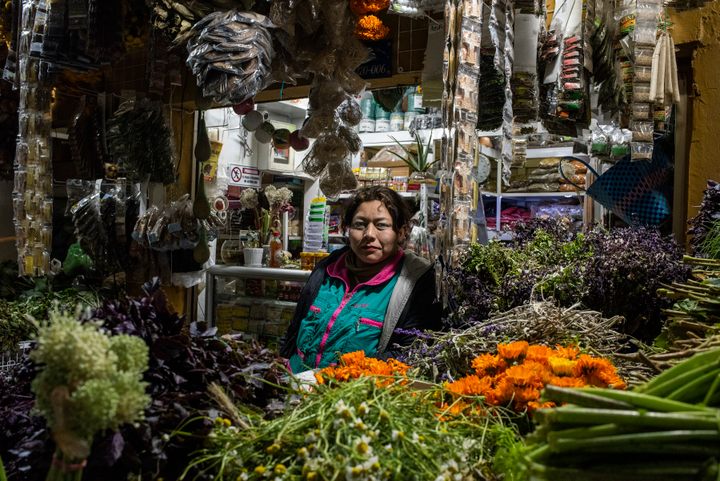
This Bogotá Market Comes Alive Only at Night, Full of Ancient Plant Lore and Astonishing Biodiversity
Farmers and foragers set up at sunset to sell hundreds of species valued in traditional medicine and ritual.
The plaza announces itself as an aroma. It’s near midnight in the Colombian capital of Bogotá, a city of 8 million, tucked in the Andes at an elevation of 8,660 feet. Downtown is deserted as we approach the neighborhood known as Los Mártires. The narrow streets fill like rivers with a sweet and earthy current reminiscent of licorice and chamomile, wood and the smell of incense during a Catholic Mass. Trucks pass by loaded with piles of herbs and sometimes trees, some illuminated by portable fluorescent lights. Men ride bicycles carrying bunches of herbs bigger than they are. We are all heading to the same place: the Plaza Samper Mendoza.
The plaza, once a parking lot and now dominated by a basic, warehouse-like building, is unique. Open on Mondays and Thursdays, its vendors sell only plants and herbs traditionally used in folk medicine, including esoteric applications, and cooking. It’s also the only market in Bogotá—or, for that matter, in any Andean capital—that opens after sunset. For decades, the night market was overlooked and underappreciated by the city government. Its vendors, mostly low-income locals, small-scale farmers, and Indigenous peoples, faced prejudice and even persecution. But that’s changing. Scientists recently documented the plaza market as a living plant archive of hundreds of species, and a rich repository of plant lore and other traditional knowledge.
When we arrive, the streets around the plaza are full of activity as men unload trucks and carry enormous bales of herbs through the crowd. Near the market’s main entrance, beside a woman selling arepas, Humboldt Institute biologist Germán Torres Morales is waiting for us.
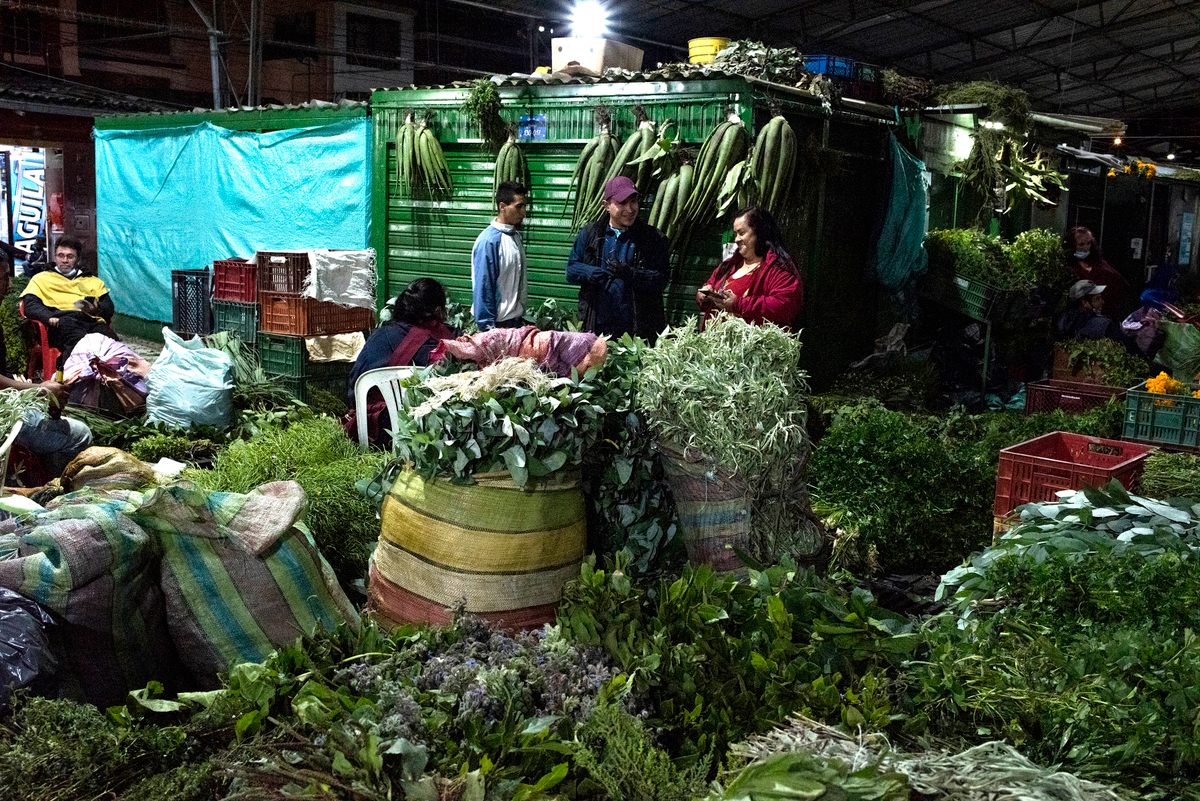
“I really didn’t expect to find anything unusual. I was expecting to find the same as always: thyme, bay, sage,” Torres Morales says, referring to the recently completed, first-ever comprehensive biodiversity survey of the market’s inventory, a project he led. “But the amount of species is just…” He stops mid-sentence as if lost for words about what his team found.
The results, published by the institute in 2021, identified nearly 400 plant species sold at the market, most of them native and five of them found only in Colombia. Some of the species traveled hundreds of miles to the market from the Colombian Amazon, where they were collected. Dozens of the plants identified are used in food preparation, including as seasoning. More than a hundred others have reputed magical properties, and 287 are used in myriad folk remedies for everything from headaches to weight loss.
In Colombia, as in many other tropical countries, tips on using plants to treat an ailment—or change your luck—seep freely into conversations. However, a 2013 paper found that ethnobiological research on Colombian traditions is scarce compared with other Latin American countries, such as neighboring Brazil, Perú, and Bolivia. And, according to a 2014 paper, most of the knowledge that has been collected comes from Indigenous communities in the Amazon, excluding Afro-Colombian communities on the Pacific Coast and Andean farmers, including those who sell their herbs and other plants at Samper Mendoza.

Losing this knowledge is a way of severing the ties that bind cultures and people, says Carolina Romero, a Colombian ethnobotanist at the Missouri Botanical Garden who was not involved in the recent night market study. “It’s not only the knowledge of what the thing does to your body, or what makes you heal, but [it’s] this connection with everything that makes us feel Colombians: the plants at the patio, boiling them and smelling the air, and drinking it. All these memories [and] sensations that go with it.”
For three months in 2021, Torres Morales and a team of biologists, anthropologists, economists, and forest engineers visited the night market. As the biologists took samples of each species, often buying entire bunches, the anthropologists and economists spoke with vendors, taking careful notes: bathing with the pink and red petals from the shrub quereme hembra (“love me female” in Spanish) will attract a lover, the vendors said, while an infusion of the leaves of desvanecedora (“the vanishing”) will eliminate cysts, fibroids, and tumors. For shiny hair, apply a paste of rosemary and cola de caballo (“horsetail”).
As we enter the market, vendors recognize Torres Morales and greet him warmly. Mónica Adriana Quimbayo, “La Mona,” asks him how he’s been. “She’s the one that knows everything,” he says as he introduces us.
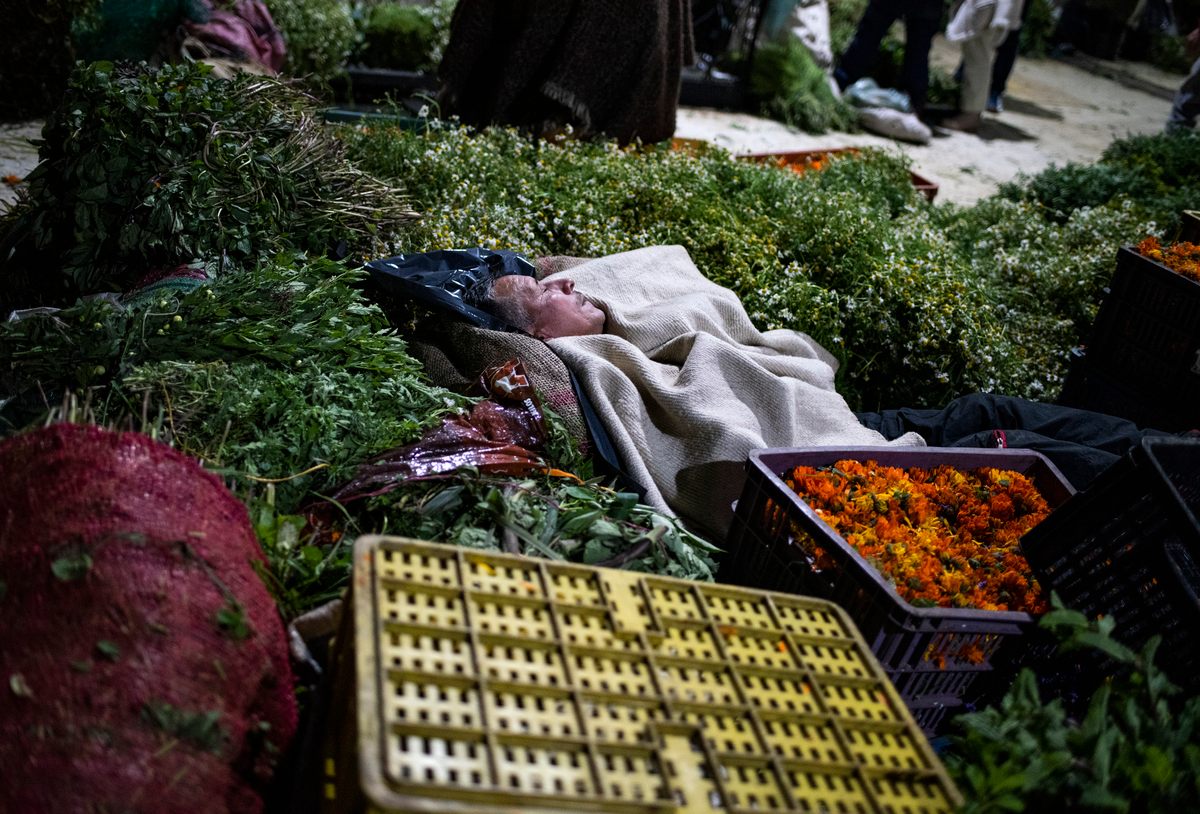
Quimbayo, 37, has worked at the market since she was 16 years old. Growing up, her family rarely went to the doctor. If she had a fever, her mother would give her a plum-leaf infusion or would make her sleep on a bed covered in a plant known as matarratón. “The knowledge I have of these plants is really sacred,” she says. “It’s like a puzzle. One part comes to me from my genetic roots, and the other because the women who used to own this stand told me the secrets of things.” She lives in Bogotá with her husband, who also works at the market. Her father, another vendor, still lives in her hometown of Coyaima, a five-hour drive away.
Most of the market’s vendors grow the plants they sell on small farms, but others forage for wild plants, “deploying highly specialized knowledge,” says anthropologist and coauthor María Camila Méndez. Some of the foragers come from the outskirts of Bogotá; others leave their distant villages at dawn, sometimes driving up to seven hours, to set up their stall every Monday and Thursday night and stay until after sunrise selling their fragrant finds.
As part of the research project, Méndez pieced together the long history of the market. She found 19th-century documents that mentioned farmers and Indigenous people sold plants for medicinal and “magical” use in a large public market at the heart of the city. However, in 1864, pressured by developers who had recently opened a nearby shopping mall for Bogotá’s elites, the city closed the market. It relocated some of the vendors, but not those who sold plants valued in traditional and folk applications. After all, at the time, the elite classes viewed farming—and farmers—as dirty and incompatible with a modern, cosmopolitan Bogotá, Méndez says.
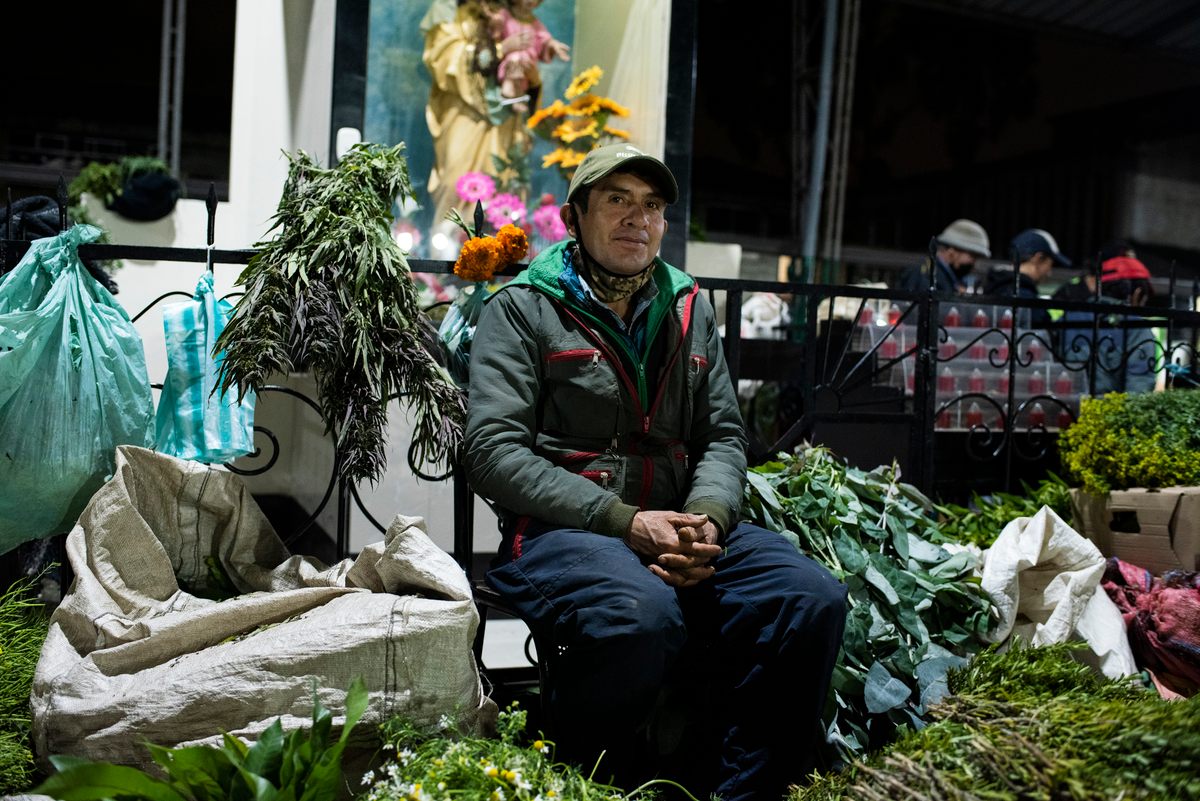
Without a designated place, for decades the sellers moved around town, hoping that police wouldn’t harass them for “invading public space” and confiscate their plants. For a time, the market operated at a plaza in front of the headquarters of the country’s national intelligence agency. In December 1989, the Medellín drug cartel bombed the locations, killing more than 60 people, injuring hundreds, and destroying a large area of shops and other businesses. The market relocated to abandoned railroad tracks for a few months, until the city government finally permitted them to set up in Plaza Samper Mendoza, which had been used as a parking lot for decades.
“It wasn’t like what you see today,” says longtime farmer and vendor Rodolfo Pedroza, describing a gravel surface full of holes that turned into ponds when rain poured through the dilapidated roof. Tile floors and a new roof were not added until 2019.
In late 2020, as the pandemic submerged the country in a deep economic crisis, the Instituto para la Economía Social (IPES), the entity in charge of plaza markets in Bogotá, approached the Humboldt Institute about the Plaza Samper Mendoza. IPES wanted to learn more about the plants for sale, and their potential economic or scientific value.
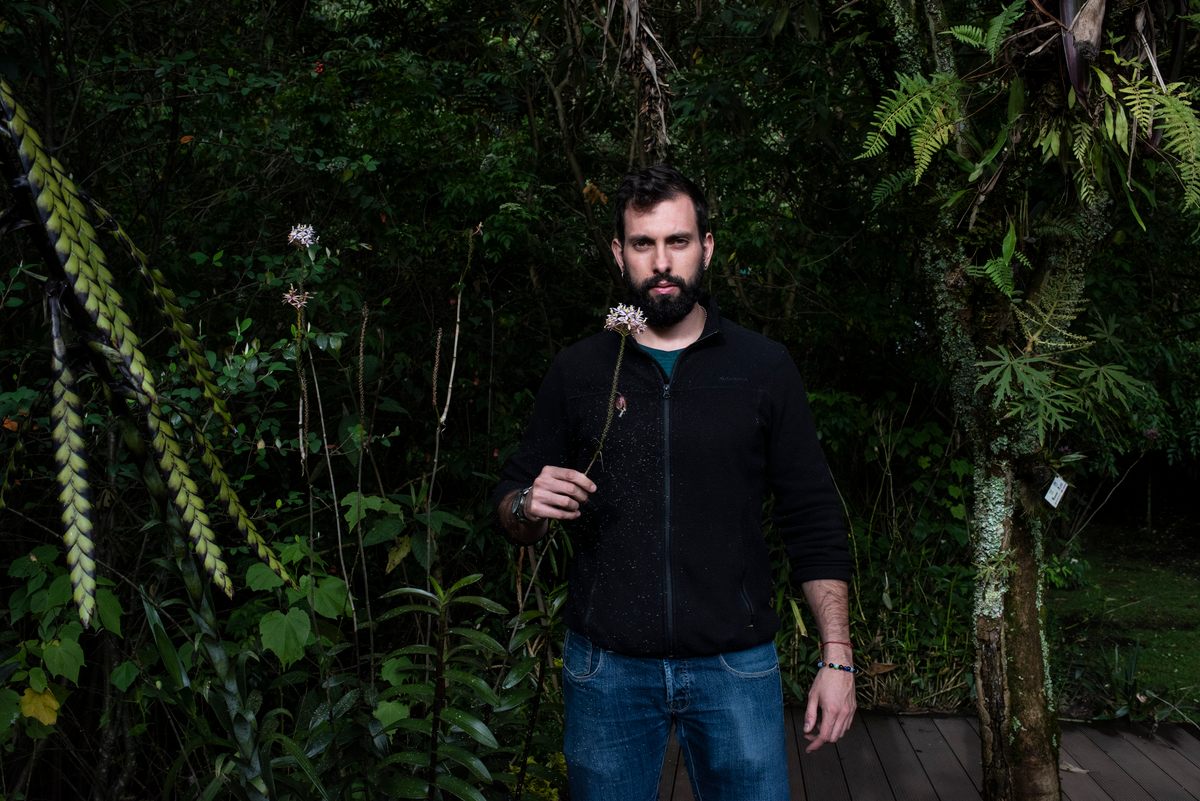
Torres Morales was ecstatic to learn he would lead the project. “I felt like I was floating,” he says. Originally from Colombia’s mountainous coffee belt, his childhood memories are rich with plant lore, from an aunt teaching him the traditional uses of trees and flowers on long walks through the countryside to the smell of the small bunches of cinnamon, elderflower, and eucalyptus, all said to attract good things, that his mother burned at home.
In the months the team visited the night market, Torres Morales says that, by dawn, purchased plants would fill his living room. He would stuff them in his car and drive up to the hills, where the Humboldt Institute overlooks the city. In the lab, he would trim each plant, record the species and note the smell and colors of each of its parts. Then he would wrap one branch of each plant in old newspaper and sandwich it between cardboard and zinc sheets, which help to distribute heat evenly. The plants were then dried in an oven, set at a low temperature, for a few days. Eventually, the specimens were sent to the institute’s herbarium, located in the small town of Villa de Leyva, northeast of the capital.
“Most of the plants we collected were not in the herbarium,” Torres Morales says. While Colombian botanists have documented more than 50,000 native plant species, they have generally focused their research on remote mountains, forests, and wetlands. It’s an enduring legacy of ethnobotanical expeditions in the mid-20th century, when scientists focused on the Colombian Amazon. As a result, plants foraged around urban areas or grown by farmers—and the traditional knowledge of their use—were largely ignored. Recently, however, there has been renewed interest in ethnobotanical research, particularly at Humboldt. “We’re like, the scientific hippies here,” says Torres Morales with a laugh.
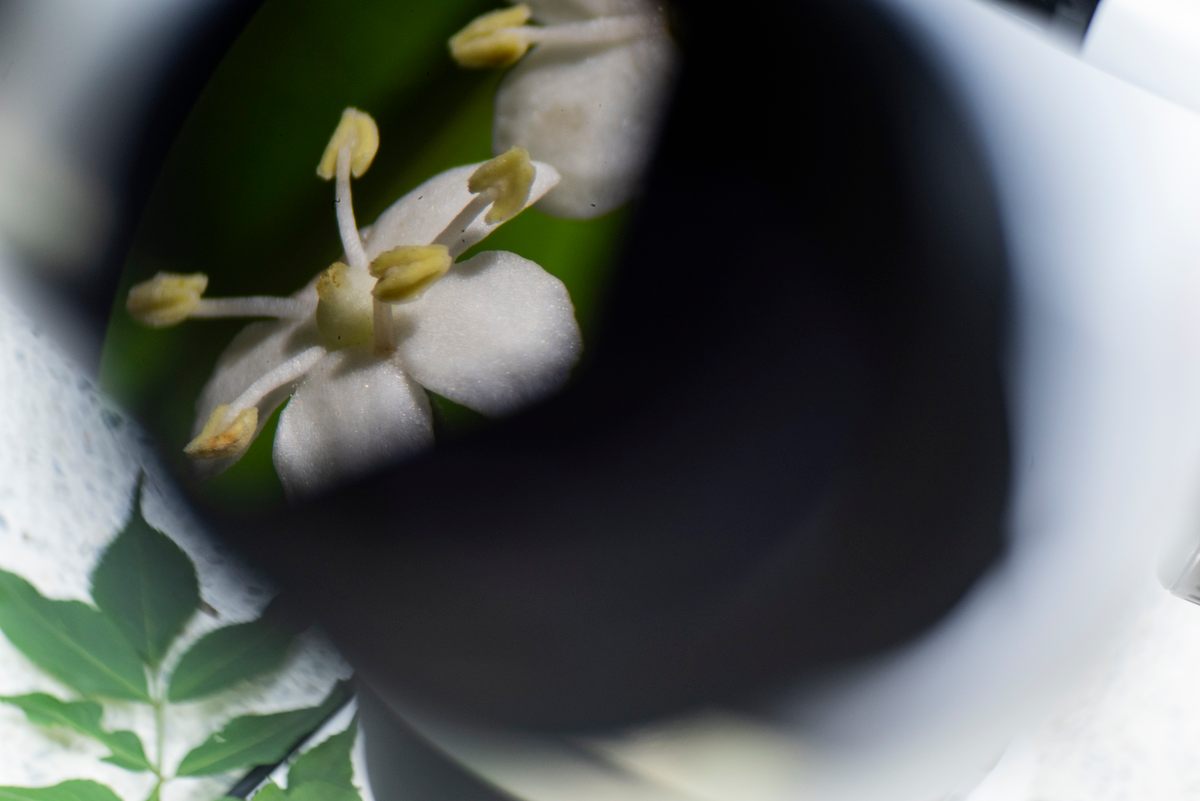
In addition to creating the first inventory of species sold at the market, the team is now exploring potential commercial uses for several of the plants with partners in both the food and pharmaceutical industries. It’s another step in expanding understanding of the country’s biodiversity, and the centuries of traditional knowledge that celebrates it.
“With this research I feel that I fulfilled one of the great dreams of my life. From using plants in a very mystical and personal way to using them, in this way, for work,” says Torres Morales. “It was like a gift from life. It was connecting me with my ancestral part, and with other ways of doing science.”

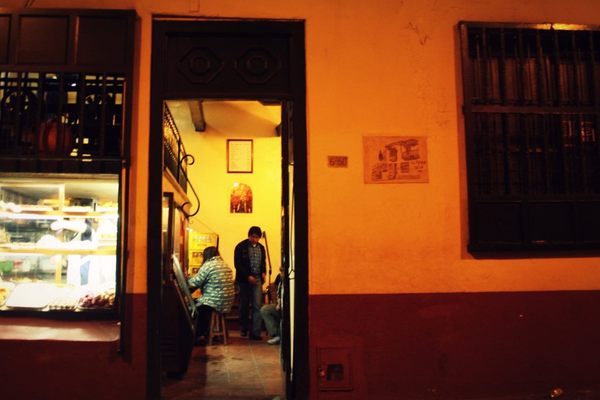


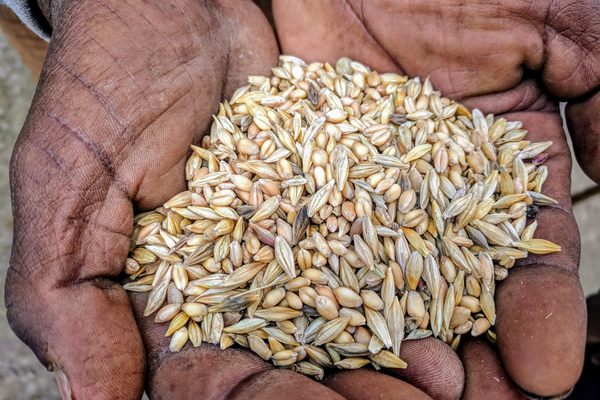
































Follow us on Twitter to get the latest on the world's hidden wonders.
Like us on Facebook to get the latest on the world's hidden wonders.
Follow us on Twitter Like us on Facebook